I LOVE learning about what therapy materials other SLP’s use. I know on the speech message boards and Facebook groups this is a common topic. Today I am going to share 10 therapy materials that I cannot live without. If you didn’t catch it last week, I shared with you 15 Kids Games I Can’t Live Without in my therapy sessions.
I have used these materials with preschool through middle school and some with children with moderate to severe impairments in high school.
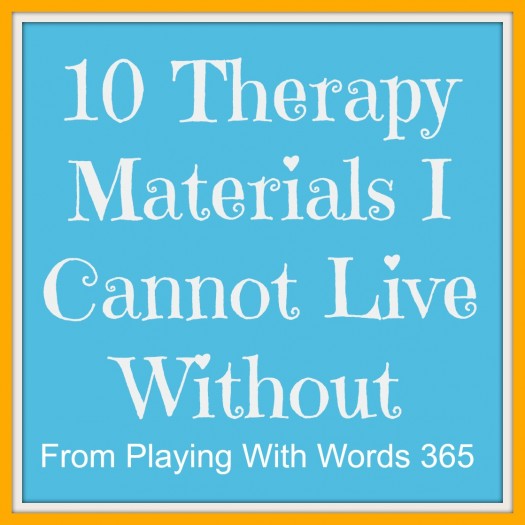
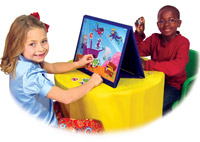 1. MagneTalk Match Up barrier game by Super Duper Inc. This is by far one of my MOST favorite materials. I have used it with preschoolers up through 8th grade. Yes even some of my 8th graders with mild-moderate disabilities enjoyed these. When I had to resign from my former district when I had my daughter, this was by FAR the most painful material I had to part with since my district had purchased it for me. Lucky for me Super Duper had it on sale a while back and I snatched it up! The only real downfall of this product is the price tag. To be fair though, the magnets are THICK and in addition to the board, 5 picture scenes, and 100 magnets, you get a workbook and CDrom of additional activities. I would just watch and wait for it to go on sale!
1. MagneTalk Match Up barrier game by Super Duper Inc. This is by far one of my MOST favorite materials. I have used it with preschoolers up through 8th grade. Yes even some of my 8th graders with mild-moderate disabilities enjoyed these. When I had to resign from my former district when I had my daughter, this was by FAR the most painful material I had to part with since my district had purchased it for me. Lucky for me Super Duper had it on sale a while back and I snatched it up! The only real downfall of this product is the price tag. To be fair though, the magnets are THICK and in addition to the board, 5 picture scenes, and 100 magnets, you get a workbook and CDrom of additional activities. I would just watch and wait for it to go on sale!
Here is the description from Super Duper’s website:
This one of a kind, magnetic masterpiece targets a ton of language and listening skills. Best of all, the barrier game format is perfect for following directions, giving directions, storytelling, improving vocabulary, and a whole lot more! Your students will have a blast going camping, swimming through the ocean, and traveling to outer space while learning to listen and use language effectively. The kit even includes a reproducible workbook (with a French translation on the CD-ROM) to make homework and group activities a breeze. It targets: following directions, deductive reasoning, giving directions, vocabulary, auditory memory, storytelling, basic concepts, categorization, rhyming, and listening.
Why I love it:
- Can be used to target a variety of goals (see my post on Barrier Games for more info on how to use these in therapy). This is great when you have mixed groups with language, artic, fluency, and pragmatic goals! And don’t worry….you can use it in groups easily…I just pair the kids up. I also had two boards so I could have two set up at once!
- Can be used across various ages…another great feature if you have a wide caseload (I had preschool and 4-8th graders for a few years, so I had to have materials that could adapt for different ages).
- The stand is also a double sided dry erase board which I have used for all KINDS of things!
There are three different sets, the Adventures Kit (described above), the Fantasy Story Kit (which I used in the past) and the Around the World Kit (I’ve never used this one). It also comes with a storage bag to keep everything organized. A tip: I use ziplock bags to keep the magnets organized, I find this easiest.
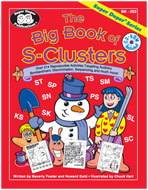 2. The Big Book of /s/ Clusters from Super Duper Inc. This one is fantastic for homework or for activities to keep the kids busy when they are waiting for a turn in a group. I personally use these for homework for my preschoolers who are working on the different /s/ blends. Here is the description from the Super Duper web site:
2. The Big Book of /s/ Clusters from Super Duper Inc. This one is fantastic for homework or for activities to keep the kids busy when they are waiting for a turn in a group. I personally use these for homework for my preschoolers who are working on the different /s/ blends. Here is the description from the Super Duper web site:
We think this is the best S Cluster (S Blends) book in the whole world! Why? It has 200 pages of fantastic art and an exhaustive array of auditory bombardment lists, discrimination pictures, target pictures, sequencing stories, puzzles, mazes and more to help your children learn their S Blend sounds. It includes activities for initial SP, SM, SN, ST, SL, SK, final -PS,-TS,-KS, and combination of all initial/final S Clusters. This is one BIG book!
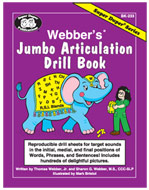 3. Webber’s Jumbo Articulation Drill Book from Super Duper. I personally have this one on CDROM. What I have done, is printed out all the pages I would use in my therapy sessions, put them in sheet protectors, and then put them in 3 ring binders by sound. I have the binders organized by probes, tips on how to elicit the sound, words, sentences, and different pictures to use to work on the sounds at the conversational/storytelling level. This way, when I am working with groups of students, they can walk in and grab the binder of the sound they were working on. We use dry erase markers on the pages to mark of words we were working on, or to just draw on between turns 🙂 I have made binders for the most common sound errors.
3. Webber’s Jumbo Articulation Drill Book from Super Duper. I personally have this one on CDROM. What I have done, is printed out all the pages I would use in my therapy sessions, put them in sheet protectors, and then put them in 3 ring binders by sound. I have the binders organized by probes, tips on how to elicit the sound, words, sentences, and different pictures to use to work on the sounds at the conversational/storytelling level. This way, when I am working with groups of students, they can walk in and grab the binder of the sound they were working on. We use dry erase markers on the pages to mark of words we were working on, or to just draw on between turns 🙂 I have made binders for the most common sound errors.
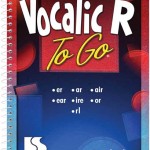 4. Vocalic R to Go by Beverly Plass at LinguiSystems. This book has word lists, activities and worksheets for the vocalic /r/ organized by the type (ar, er {stressed and unstressed}, ire, or, ear, air, rl). The book comes with s CD rom of the entire book so you can easily print pages off you need. I suggest printing it off and placing the pages in sheet protectors and placing it in a binder…you can print out several copies of each page and hand them out to students as they come in. If you choose to make an /r/ binder (or several) like I did, you can add these pages to your binder.
4. Vocalic R to Go by Beverly Plass at LinguiSystems. This book has word lists, activities and worksheets for the vocalic /r/ organized by the type (ar, er {stressed and unstressed}, ire, or, ear, air, rl). The book comes with s CD rom of the entire book so you can easily print pages off you need. I suggest printing it off and placing the pages in sheet protectors and placing it in a binder…you can print out several copies of each page and hand them out to students as they come in. If you choose to make an /r/ binder (or several) like I did, you can add these pages to your binder.
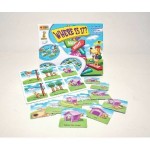 5. Where Is It?
5. Where Is It? I don’t know where I originally purchased this game but I just found it at Amazon for under $20. This is a bingo type game that teaches 24 locative concepts. My students always LOVE this simple game! I also will just use the picture cards paired with another game (like Cariboo or Don’t break the Ice). Looking for something similar? I made a set of cards you can download for free: Where is Cupid? A Prepositional Game.
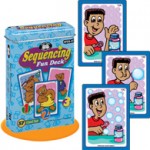 6. Fun Decks from Super Duper. There are a TON of fun decks from Super Duper, so I went ahead and put these in a group together. I have MANY of the articulation decks but I find I use the following language Fun Decks the most:
6. Fun Decks from Super Duper. There are a TON of fun decks from Super Duper, so I went ahead and put these in a group together. I have MANY of the articulation decks but I find I use the following language Fun Decks the most:
- Ask and Answer WH Cards
- All About You, All About Me
- Sequencing
- Is and Are
- That’s Silly
- Yes or No?
- How?
- What Makes Sense?Â
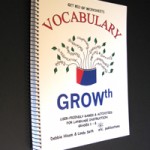 7. G.R.O.W. Series: G.R.O.W. stands for Getting Rid of Worksheets and this series of books by Linda Eve Seth and Debbie Hisam is awesome! I loathe worksheets in therapy. I will sometimes send some home for homework but generally I like to avoid them. When I work with grades 1-8th I find these books INVALUABLE. I personally own the Vocabulary GROWth book and the GROW Parts of Speech book and absolutely love them. Not only do these books provide you with TONS of activities to target a plethora of language goals, but they also provide lists that you can use in different activities (i.e. categories, prefix/suffix, parts of speech, etc). I really want to try the Do Rugs Book next!
7. G.R.O.W. Series: G.R.O.W. stands for Getting Rid of Worksheets and this series of books by Linda Eve Seth and Debbie Hisam is awesome! I loathe worksheets in therapy. I will sometimes send some home for homework but generally I like to avoid them. When I work with grades 1-8th I find these books INVALUABLE. I personally own the Vocabulary GROWth book and the GROW Parts of Speech book and absolutely love them. Not only do these books provide you with TONS of activities to target a plethora of language goals, but they also provide lists that you can use in different activities (i.e. categories, prefix/suffix, parts of speech, etc). I really want to try the Do Rugs Book next!
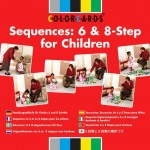 8. Sequencing Cards I use sequencing cards ALL THE TIME to elicit language, work on articulation carryover, target syntax and semantics, increase vocabulary, focus on fluency, etc. I find these invaluable! I have a few different sets of cards but my favorite is a set I purchased at a seminar several years ago called Color Cards: 6 & 8 Step Sequences for Children. I also have this set of Learning to Sequence cards.
8. Sequencing Cards I use sequencing cards ALL THE TIME to elicit language, work on articulation carryover, target syntax and semantics, increase vocabulary, focus on fluency, etc. I find these invaluable! I have a few different sets of cards but my favorite is a set I purchased at a seminar several years ago called Color Cards: 6 & 8 Step Sequences for Children. I also have this set of Learning to Sequence cards.
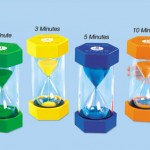 9. Giant Sand Timers and this smaller Classroom Sand Timer Set I cannot live without my sand timers. I use both the giant and the smaller ones depending on the time I need and the specific clients/students (many of my kiddos on the autism spectrum have really loved the large ones) When working in the schools, I use these daily to keep myself (and the kids) on track. I typically will have each child have a 1-2 minute “turn” and using these helps keep the time I spend working with each child as equal as possible. I also will time the children to see how many words they can say with their target sound correctly in either 60, 90, or 120 seconds. When working with some children with behavioral needs, I will use the timer as a visual reminder of how long we need to work before they get a break, and then how long the break is before they need to work again.
9. Giant Sand Timers and this smaller Classroom Sand Timer Set I cannot live without my sand timers. I use both the giant and the smaller ones depending on the time I need and the specific clients/students (many of my kiddos on the autism spectrum have really loved the large ones) When working in the schools, I use these daily to keep myself (and the kids) on track. I typically will have each child have a 1-2 minute “turn” and using these helps keep the time I spend working with each child as equal as possible. I also will time the children to see how many words they can say with their target sound correctly in either 60, 90, or 120 seconds. When working with some children with behavioral needs, I will use the timer as a visual reminder of how long we need to work before they get a break, and then how long the break is before they need to work again.
10. A Simple Token Economy. I use token economies with a wide variety of students, not just those on the autism spectrum. I have found that many of my “speech only” kids with no behavioral issues at ALL still really enjoy using these systems (depending on the type, of course). Below is a simple 10 piece token system I created years ago with Boardmaker, 10 pennies, a laminator and some Velcro. At the beginning of the session I allow the student(s) pick what they are working on, and in the last box in the sentence we either place a picture of the item/activity or write it in.
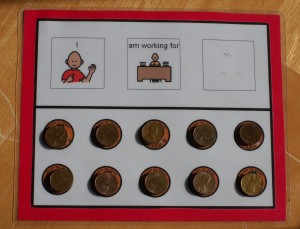
You don’t have to have an expensive program like Boardmaker to make one of these. You can use WORD to make something similar. I have used some other FREE things that I have found online as token systems. One example are my alphabet and number turkeys that I printed from DLTK Kids. I printed on card stock, laminated, and used Velcro to attach the pieces on. Some children are very motivated by letters and numbers and LOVE these! There is also a color turkey you can make.
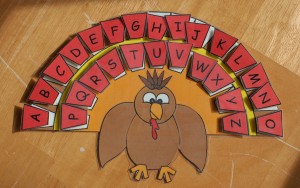
So there are 10 therapy materials I cannot live without! Now I want to hear from YOU. What materials can you not live without? I already shared my kids games I can’t live without, and will be sharing some toys and reference books that I can’t live without in upcoming posts!
Cheers!
Just a quick note: I am not being compensated in ANY way by any of the companies that make these products for mentioning them in this post. In fact, most of these companies do not even know I exist 😉 The purpose of this post is to share with my fellow SLPs (as well as other educators and parents) the materials that I personally find invaluable in my practice as I know that I personally am always interested in what my colleagues find useful! I purchased all the items above myself within the last several years that I have been practicing as an SLP.
Great list! I see some things to add to my wish list! Besides some of the products you listed, I also love Pronoun Party by Super Duper. I use it all the time to work on pronouns as well as sentence structure. It’s easy to grab and go and the kids love it.
Just thought I’d throw a tip out about using velcro. If you save the tabs off of diapers and glue them on the back of any piece, you will have an instant felt board friendly character. I love to save a buck, and when you have little ones around diaper tabs are often in plentiful supply!
This is a FANTASTIC idea Megan!!! Like seriously, I have never thought of this before! LOVE!
These are sooo super duper!!! I have such an enormous wish list now … Looks like I’ll be on a serious thrift kijiji hunt for so e second handlers cuz this resource list you share is amazing! There are SOO many different products I was never aware of until now! Thank you thank you thank you
Thank you for the resource list. We homeschool and my youngest (turning 6) still struggles with some of his letter sounds – his ‘yes’ is ‘wes’ and there are a few others. He is improving but I’m just not sure if its enough. I remember my little sister had this same problem till she was about 8 and had no lasting effect but I don’t want to overlook something that may help. Is there a resource that you recommend for this sort of speech need? Thank you!
I want to buy my granddaughter some supplies that will be useful to her when she graduates from grad school and starts to work as an SLP. Can you tell me where to get them ? Thank,you very much.